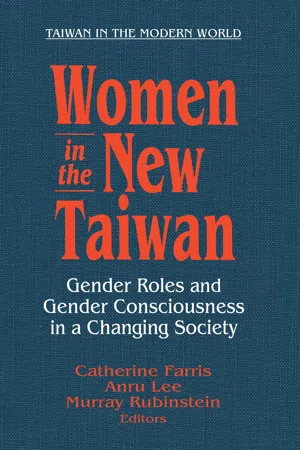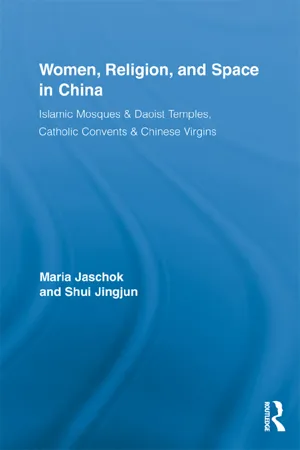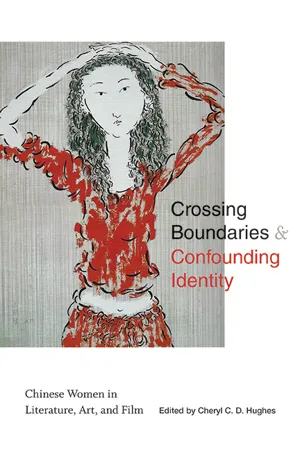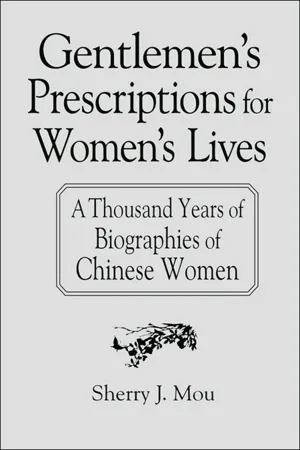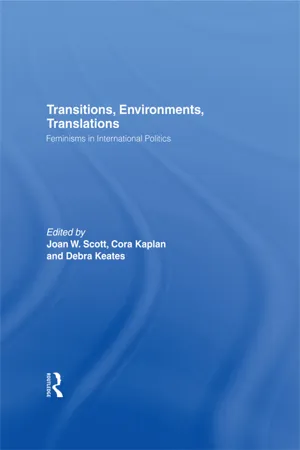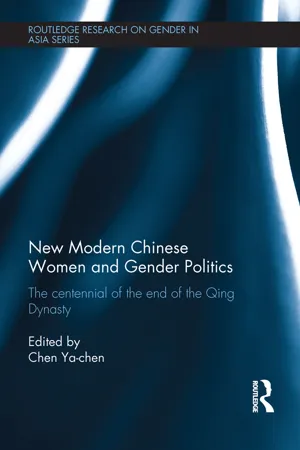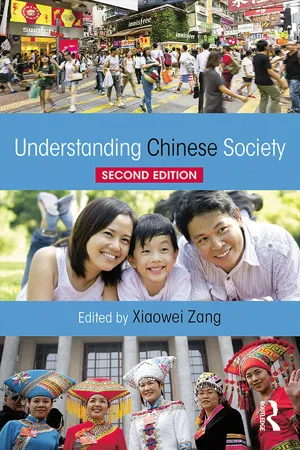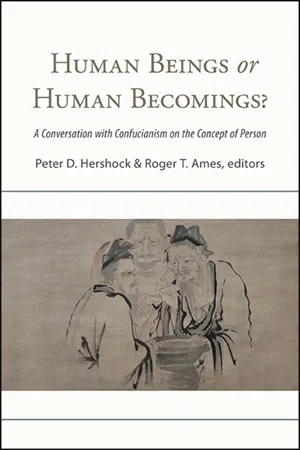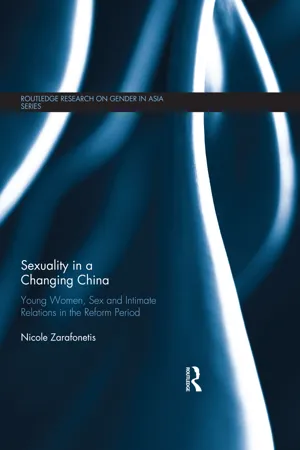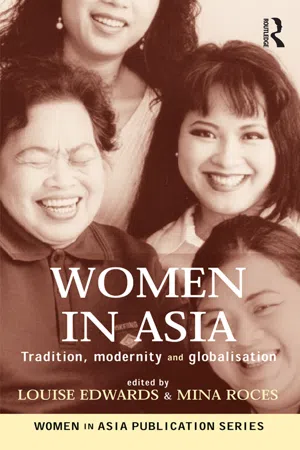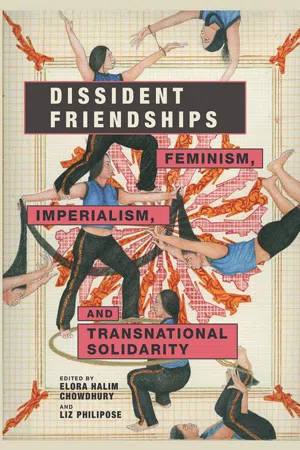History
Women in China
Women in China have played significant roles throughout history, with their status and roles evolving over time. Traditional Chinese society was patriarchal, but women still had influence within the family and community. In modern times, women have made strides in education, employment, and politics, although gender inequality and traditional expectations persist in some areas.
Written by Perlego with AI-assistance
Related key terms
11 Key excerpts on "Women in China"
- eBook - ePub
Women in the New Taiwan
Gender Roles and Gender Consciousness in a Changing Society
- Catherine Farris, Lee Anru, Murray A. Rubinstein, An East Gate Book(Authors)
- 2020(Publication Date)
- Routledge(Publisher)
4Still, as Patricia Ebrey commented at a recent academic meeting, gender as a category of analysis has yet to make a broad impact on historical studies of China, especially for earlier periods.5 In the field of China studies in the United States, research placing women at the center has yet to realize its potential to reshape the historical record.Reconceptualizing the Organization of Chinese Society in Historical Time
The first wave of historical research on Chinese women in both the United States and China was devoted to documenting and criticizing women’s oppression by men. A major target of criticism was patriarchy. Feminist scholarship on Chinese women by historians in the United States, which exploded during the 1970s, followed leads established decades earlier by Chinese historians—Chinese historians in turn were influenced by China’s own early feminist movement, especially by the May Fourth critique of Confucianism and the patriarchal family system. Ch’en Tung-yuan 1977 [1928] and others wrote the classic secondary works on which U.S. historians have relied to pursue their research on the place of women in Chinese history.In the United States recent feminist research on Chinese women’s history has now moved in different, although related, directions. The aim is not to document women’s oppression but rather to illuminate the connections between gender relations and other larger structures of power lodged in economic organizations, political structures, and so forth. For example, the first English-language historical study of prostitution in China, Sue Gronewold’s (1982) “Beautiful Merchandise: Prostitution in China, 1860–1936,” focused on the Chinese patriarchal system and the ways in which it facilitated a traffic in women’s bodies. But her evidence may be pushed beyond a critique of oppression and toward a new understanding of the broad systems and structures that organize gender relations in Chinese history. - eBook - ePub
Women, Religion, and Space in China
Islamic Mosques & Daoist Temples, Catholic Convents & Chinese Virgins
- Maria Jaschok, Jingjun Shui(Authors)
- 2012(Publication Date)
- Routledge(Publisher)
5 Such a bias has carried over into recent work, whether it probes the varied and multiple sites of an ‘indigenous Chinese feminism’ (Schaffer and Song, 2007) or offers local translations of transnational feminist discourse in terms of re/emergences of women’s sites and traditions (Ko and Wang, 2007). The diverse and changing map of women’s local translations of ideals, aspirations and transnational influences still fails the long history of believing women and thus some of the most enduring remapping of gendered ground rules. Scholarly attention to women’s religious histories is thus overdue.Central to feminist scholarship studying the history of Chinese women has been the gendered nature of inner and outer spheres of society as illuminating the particular nature of Chinese women’s status, division of labour, consanguinal and affinal relations, social distance and moral standards. It has created particular interpretations of women’s predicaments in ‘traditional’ society as victimised, passive, and vulnerable to abuse outside her allocated sphere of respectable female place and conduct (entrenched in the Confucian core concepts of obedience owed to father, brother and husband, and conduct expressive of feminine virtues).6 It led to what Mechthild Leutner (2005) characterized as victim narratives, both as object of the Chinese Communist ‘liberation myth’ (Jabri, 1996) and of Western feminist discourses on women’s oppression under successive phases of socio-political systems (Andors, 1983; Stacey, 1983; Wolf, 1985). Historians such as Ko (1994), Hsiung Pingchen (2005), Mann (1997), among many others, have forcefully questioned the appropriateness of Western feminist concepts of public/private to the study of Chinese women’s history.7In the 1990s, criticism of an Anglo-European orientation as in need of a more nuanced and multi-voice interpretation gave rise to a revision which sought to challenge long-held assumptions that the history of Chinese women is one of confinement and passivity, in which they are held in place by Confucian precepts and norms and by rigid patrilineal decrees and conventions. Historians of women’s lives in different dynastic reigns, social classes and local cultures in China—among many others, Ebrey (1993), Gilmartin et al - eBook - ePub
SUNY series in Asian Studies Development
Chinese Women in Literature, Art, and Film
- Cheryl C. D. Hughes, Cheryl C. D. Hughes(Authors)
- 2023(Publication Date)
- SUNY Press(Publisher)
Gender) According to Nathan Sivin, a profoundly different view of the body as a “congerie of vital processes” informs the Chinese imagination (qtd. in Ha 432). Man and woman are shifting categories on a continuum rather than in opposition. Thus, we see more proclivity among Chinese thinkers to consider male/female as a dialectic pair, always in relation, rather than as one gender in isolation (Zhang 129). In addition, the overwhelming emphasis on the family over the individual in Chinese culture affects the destiny of women in complex and powerful ways, negatively and positively. In ancient China, the woman was subsumed by her role in the family; she was wife, mother, daughter, or daughter-in-law more than an individual person (Rosenlee 47). Today, family duties still press harder on women than on men. Chinese culture has long celebrated women who sacrifice their own needs for the sake of the group (Carlitz 104–7). As we shall see, a recent development has been the training of daughters so that they develop their life potential, inside and outside the home. In addition, marriage has become less restrictive for women.Some feminist scholars like Marjorie Topley blame the yin concept for providing the theoretical justification for confining women to a passive role in society (qtd. in Rosenlee 68). Pioneering Chinese feminist He-Yin Zhen (1884–ca. 1920) also believed that institutions, customs, and even metaphysical abstractions spawned “insidious social hierarchies” justifying the oppression of Women in China (Liu, Karl, and Ko 14). Indeed, to break out of the patriarchal structure, Chinese women have had to sidestep the misguided view that a virtuous woman is always synonymous with yin, the female principle associated with yielding or receiving. As Rosenlee has argued, the actual theory of yin and yang does not require a woman to fully equate herself with yin and always recede in favor of men. Yin and yang are of equal importance, perpetually in motion, and in dynamic exchange with one another. They are “pivots of transformation” in a certain direction toward an approximation rather than an absolute (Miller 61). In ancient writings, yin and yang are “often cross-gender and beyond gender” (Rosenlee 65). The consummate person, male or female, alternates between yin and yang to maintain balance, reconcile opposites, and achieve excellence in life (Hall and Ames 93). - eBook - ePub
Gentlemen's Prescriptions for Women's Lives: A Thousand Years of Biographies of Chinese Women
A Thousand Years of Biographies of Chinese Women
- Sherry J. Mou(Author)
- 2015(Publication Date)
- Routledge(Publisher)
1 From The Biographies of Women to the Biographies of Chaste Women Introduction China has a fairly continuous tradition of written records that goes back about four thousand years. Many of those records consist of historical documentation. Therefore, it should be possible to establish a much longer history of Women in China than elsewhere, despite the fact that nearly all historical documents were written by men and focused on the affairs of men. The last quarter of the twentieth century saw a flourishing of studies of women’s histories in the West. The last two decades’ increasing fresh focus on topics related to women in Chinese studies indicates that scholars are indeed striving to establish a longer history of Chinese women. 1 Most studies focus on late imperial China, especially the Ming and Qing dynasties 2 and the period from the late Qing to the present. For example, Meng Yue and Dai Jinhua’s Fu chu lishi dibiao (Voices emerging into the foreground of history: A study of contemporary Chinese women’s literature) reexamines the consciousness of the male authors of the May Fourth generation and maps out a genealogy for the female writers of the twentieth century. 3 Susan Mann’s Precious Records looks at how, building upon China’s long history of men’s writing about women, Qing women went further to try to build their own version of women’s history. Patricia Buckley Ebrey’s study of women in the Song dynasty pushed class to the foreground, showing how upper-class and peasant women’s lives differed. While upper-class women remained mostly “inside helpers,” peasant women’s work often involved frequent coming and going between the house and the fields. 4 Such women-centered and women-based studies challenge the beliefs, prevalent since the nineteenth century, that Chinese women are helpless victims of traditional Chinese culture and that their salvation will come only from the new learning and new value system of the West - eBook - ePub
Transitions Environments Translations
Feminisms in International Politics
- Joan W. Scott, Cora Kaplan, Debra Keates(Authors)
- 2013(Publication Date)
- Routledge(Publisher)
Women’s movements rejected these views and resisted regression in female working and living conditions. It is here that the positive side of postreform social changes also manifests itself. In the space no longer occupied by the state and its ideologies, autonomous activities, fresh information, unfamiliar concepts, and, indeed, free thinking flourish. Women welcomed these changes because they brought new possibilities for action. Their position is necessarily contradictory: They lost preferential treatment by the state but gained freedom and independence in their relationship to the state. It is in this space of contradiction that women’s movements in China have positioned themselves in order to explore and renovate the meaning of liberation.“FEMINISM”These developments, from the growth of women’s studies in the universities and other research institutes to the wider political-social activities for women’s rights and interests, are recent phenomena compared to what has taken place in Europe, the United States and many “third world” countries. The belated formation of women’s movements in China, and many of their peculiarities, can be explained only by China’s unique historical trajectory, which has precluded a separate feminist politics. Modern Chinese history was, at least in part, a history of simultaneous revolutionary struggles against both external imperialist powers and domestic “feudal” traditions. In these struggles women’s emancipation was synonymous with national and social emancipation. Consequently male domination has not been a separate problem for universal nationalist or socialist agendas. The idea of “modernization” has inspired many different movements. Both the earlier Republican revolution, which involved the heroic participation of educated women, and the later Communist mobilization of women workers and peasants claimed to be “modern.” The official postrevolutionary definition of women’s work and the present women’s movements for self-determination are also on the side of modernity. Modernization, without being linked with any particular theoretical or actual models in the West, has served the Chinese as a sign, signifying a just alternative to a traditional past when women were always at the bottom of society. The emancipation of women thus was an indicator of modernity. By this standard, the Communists can be seen as the most effective modernizers. - eBook - ePub
New Modern Chinese Women and Gender Politics
The Centennial of the End of the Qing Dynasty
- Chen Ya-chen, Ya-chen Chen(Authors)
- 2014(Publication Date)
- Routledge(Publisher)
Past interpretations that represent the West as a hegemonic agent capable of imposing its will on others despite opposition obscures the complexity of transnational power. Few places could serve as better examples of the limits of Western agency and Western concepts than China. China seems to defy easy classification by Western intellectual models; it has an authoritarian and communistic political structure with a capitalist economy; its culture is politically censored yet embraces critical postmodern artistic representations in major urban areas (such as the 798 Arts District in Beijing); its capitalist economy shares productive aspects with the industrializing nations and consumerist aspects with the most industrialized nations; its labor conditions can resemble those in the least industrialized nations but there is also a growing “middle class” (Li 2012). History of women's liberation and change in fashion before 1902 Prior to the twentieth century, gender relations in China were based on traditional patriarchal forms where women’s entrance into or participation in public spheres was strictly limited and controlled. Chinese feudalist traditions originated in the moral and political philosophy of Confucius. Of particular note for the topic at hand was the notion of “filial piety.” Filial piety maintained a hierarchy of authority and stipulated that women must be obedient to men, citizens to their sovereigns, and youths to their elders (with the exception of widowed mothers being expected to obey their sons). Women were oppressed by strict ethical codes prohibiting them from social activities. They were expected to be good daughters, wives, mothers, and mothers-in-law. All rights, such as owning property, seeking divorce, working, receiving an education, or participating in politics were solely the rights of men. Chinese women suffered much from male-dominated culture under this patriarchal structure - eBook - ePub
- Xiaowei Zang, Xiaowei Zang(Authors)
- 2015(Publication Date)
- Routledge(Publisher)
However, in keeping with Marxist theory, which locates gender issues within class struggle (Landes 1989), the CCP’s attempt to uphold women’s interests was subordinated to an extent by other prioritized efforts in building the socialist nation. For example, women were called upon to return home and be good housewives in the early 1960s when there was huge unemployment pressure (Andors 1983). As a result of competing interests, the Women’s Federation often struggled with its role of assistant to the CCP’s central work and role of protector of women’s interests (Jin 2001). During the Cultural Revolution (1966–76), class issues took precedence and, despite slogans such as ‘Women hold up half the sky’ and ‘What men can do, women can do’, hardly any official attention was given to women’s issues (Honig 2002). The exception is the 1973 campaign to criticize Confucianism, which offered a rare moment for gender inequality to be openly addressed in the context of a political campaign (Andors 1983; Johnson 1983; Croll 1980). After Chairman Mao’s death in 1976, the Chinese government adopted an approach to socialist construction that was centred on economic modernization, and women’s emancipation was subsumed by this priority (Honig and Hershatter 1988). This meant that only limited progress in the promotion of gender equality in China was achievedFor example, the mobilization of women into the workplace in the post-1949 era mentioned above has not exempted them from their more traditional duties, such as being a good wife and mother. Although men were called upon to do a share of domestic work, research has shown that women continued to spend far more time undertaking domestic tasks (Research Institute, All China Women’s Federation 1998: 473, Table 9.1). The strong cultural association of women and family meant that women entered social production on terms that were not equal to those of male workers, and through a vicious circle of devoting more time to domestic duties, reinforced the workplace gender hierarchy. Contemporary narratives of urban industrial women workers show that, unlike their male counterparts, women suffered from time poverty, juggling work and family duties, and this made it difficult for them to invest time in cultivating social connections that would benefit their career (Liu 2007a). Rural studies demonstrated the double burden upon women affected their ability to earn work points and be active in political campaigns (Andors 1983; Hershatter 2004). - eBook - ePub
SUNY series in Chinese Philosophy and Culture
A Conversation with Confucianism on the Concept of Person
- Peter D. Hershock, Roger T. Ames, Peter D. Hershock, Roger T. Ames(Authors)
- 2021(Publication Date)
- SUNY Press(Publisher)
53 Such undertakings do not point in the direction of uncritical acceptance of current gender roles—whether in East Asian societies still influenced by Confucianism or more westernized societies upholding gender equality as idealized by Anglo-European philosophical traditions. As a reflective normative philosophy, Confucianism today cannot simply adapt itself to current gender roles, any more than it should revive traditional roles, which are both far from ideal.Gender Relations in China TodayWomen’s liberation was considered central to China’s modernization in the nineteenth-century intellectual elite’s preoccupation with the “woman question” and the Chinese Communist Party’s belief that the achievement of gender equality was necessary for national strength and social progress. Laws and regulations to safeguard the legitimate rights and interests of women in the labor market, to promote gender equality, and to enable women to play more active roles in society have been introduced since the beginning of the twentieth century, with new laws on job promotion, contract labor, and rural land use aimed at promoting gender equality propagated as late as 2008. The Chinese state also adopted a Development Plan for Women for 1995–2000, followed by a second plan for 2001–2010, and a third for 2011–2020.54 Yet, the modernizers’ narrative of Chinese women progressing from a state of subjugation in the premodern period toward liberation and gender equality in modern times is far too simplistic: “Some types of gender inequality have become less common, while others appear to have changed relatively little. Yet other types of gender inequality and some problems for women appear to have been exacerbated or created in the post-Mao period.”55Many patriarchal values and practices remained embedded in social, economic, and political policies since 1949, with the aspiration of gender equality subordinated to more urgent agendas. State policies under the Communist Party often built on traditional patriarchal social arrangements and norms to achieve their economic and political goals, and economic reforms have exacerbated some forms and introduced new forms of gender inequality. Chinese women continue to suffer injustice in the revitalized preference for sons in most of China in the post-Mao period and exacerbated by “gender blind-spots” in some policies, in the gendered division of work resulting in women’s “double burden” of full time (under)paid work and major responsibilities for child care and housework, under-representation in politics and other domains, especially in positions associated with power and prestige, in the disparity between their shares of economic contributions and benefits both at home and at work, in violence against women in the form of infanticide and wife battering, attitudes about the proper qualities of husbands and wives, and the pressure exerted on young women to get married, often against their economic interests and independence.56 - eBook - ePub
Sexuality in a Changing China
Young Women, Sex and Intimate Relations in the Reform Period
- Nicole Zarafonetis(Author)
- 2017(Publication Date)
- Routledge(Publisher)
et al ., 2008). This supervision becomes even more apparent when examining the status of women in the reform period.Women and economic reform
Despite Party-State commitment to women’s issues, gender inequality remains deeply implanted within Chinese society. Economic change and the one-child policy have contributed to profound shifts in women’s personal lives (Zhao and West, 1999; Mu, 1999). Women have experienced dramatic changes in lifestyle, including new financial pressures of reform and modifications in childrearing practices and family structure (Pan, 2006). With traditional gender norms and practices remaining largely unchanged, especially concerning the role of women in marriage as responsible for maintaining familial harmony, women are faced with the double burden of caring for and raising family members and looking after the household, as well as dealing with the demands of the new market economy (Pan, 2006; Jackson et al ., 2008; Chen, 2004). Traditional Confucian values, such as filial piety and the preference for sons, also remain prevalent, yet are impossible to fulfil due to both policy constraints and the expenses of childrearing.The rejection of the economics of the Mao period has encouraged the resurgence of a rhetoric of gender difference, with women described in terms of biological difference and reproductive capacity (Zhao and West, 1999; Evans, 1997).6 With official statements on gender resembling those of the 1950s, gender equality is clearly not a state priority (Hong Fincher, 2014).7 - eBook - ePub
Women in Asia
Tradition, modernity and globalisation
- Louise Edwards, Mina Roces(Authors)
- 2020(Publication Date)
- Routledge(Publisher)
In 1994 the Information Office of the State Council of the PRC published a document titled ‘The Situation of Chinese Women’ as part of its preparation for the 1995 Fourth World Conference on Women. Beijing hosted this conference for the UN and was keen to demonstrate to the international community the remarkable progress made in Chinese women’s rights since 1949. The report declares:In later paragraphs, the report acknowledges that problems remain in the realisation of gender equality.New China proclaimed that Chinese women enjoy equal rights with men in all aspects of political, economic, cultural, social and family life and that they have become, like all Chinese citizens, masters of the state and society. Chinese laws guarantee that women and men enjoy the same rights and status and have equal personal dignity. The Chinese government employs legal, administrative and educational means to eliminate all kinds of discrimination against women and protect their special rights and interests (Information Office 1994, p. 9).China is a developing country. Owing to the constraints of social development and the influence of old concepts, the condition of Chinese women is still not wholly satisfactory. There exist various difficulties and resistance which have prevented the full realisation of equal rights to women…. Instances of…discrimination against women and even infringement of their rights still occur from time to time (Information Office 1994, p. 9).The current official explanation for the continued existence of problems for women draws on ‘development’ rhetoric which places China on a teleology stretching from underdeveloped nation through developing nation to developed nation. In this problematic view the woman problem will be solved once ‘developed’ status has been achieved. Gender equality is conceived as a luxury of wealthy and ‘modern’ nations that have discarded tradition (see Stivens 1998). However, even this CCP-authorised refinement of the grand narrative is being undercut by an increasing diversity of stories on women’s lives in China. - eBook - ePub
Dissident Friendships
Feminism, Imperialism, and Transnational Solidarity
- Elora Chowdhury, Liz Philipose(Authors)
- 2016(Publication Date)
- University of Illinois Press(Publisher)
Similar to Teng, I argue that the marginalization of Chinese women in (Western) feminist literature (1) presents a distinctive challenge to a Western paradigm case (“free us” versus “oppressed them”); (2) shows us that the complexity and changes of Chinese cultures (and women) remain to be examined more thoroughly by (Western) feminist theories; and (3) demonstrates the promise of the transcultural approach, which not only addresses why there is a lack of Chinese women’s voice in the feminist scholarship, but also offers an approach to forge women’s solidarity globally. For instance, there are feminist scholars who manage to forgo the image of Chinese women as victims and instead focus on describing Chinese women as courageous, sophisticated, and freedom seeking. One example is Tani E. Barlow’s highlight of “the new woman” in her reading of Chinese literature. “The new woman” characters created in the fiction lived during the 1920s in China, who vacillated between the fear of not being able to “escape the constraints of sexed subjectivity” and the desire to “establish a personal standing in society” (2004, 134) and between “progressive feminism and political anarchism’” (150). Another example is Tze-Ian D. Sang’s study on female same-sex desire in modern China. Sang’s study investigates “the conditions that enable the emergence of a distinctive lesbian identity in modern literature in Chinese” in the twenty-first century (2003, 34). Barlow’s and Sang’s accounts of Chinese women make a significant contribution to revealing the sophistication of “Other women” and are good examples of utilizing transcultural experiences acquired from thorough research of Chinese literature and social reality.Second, the transcultural approach can help us explore the uniqueness and complexity of Chinese women’s situations. Chinese women have their own understandings of issues that are of concern to both them and Western feminists; for example, in the context of poverty elimination, Chinese women view reproductive rights differently from U.S. feminists (note that I fall prey to the same feminist discourse by discussing reproductive rights thanks to the great visibility of this particular topic). It is broadly accepted in the United States that women’s reproductive rights are women’s rights and thus human rights, so the Chinese state regulation on women’s reproductive rights is viewed as oppressive and inhuman. However, the assumption that there is a positive correlation between economic growth, population control, and the advance of women is generally accepted without critical examination in China. An immediate but complicated case is the Chinese government’s one-child policy, which Western feminists criticize as detrimental to women, but the policy has broad support in China, especially among urban Chinese women. To understand Chinese women’s “insensibility” to, acceptance of, and support of policies that are claimed to be anti—human rights, we need to locate these issues within the historical and contemporary context of China rather than speculating and scrutinizing them from a universalist (and Western) point of view. While some scholars such as Susan Greenhalgh are concerned with state control over women’s bodies and subjectivities and at the same time being cautiously hopeful about creating “a feminist sphere of public discussion and debate on population” (2001, 874), other scholars are more positive about the impact of the one-child policy on women’s lives. For instance, through a study of China’s rural daughters, Zhang Hong arrives at the conclusion that “response to and strategies around the state population policy and new employment opportunities may vary from area to area. In some areas the pressure to comply with the birth-planning policy may have intensified son preference and increased daughter discrimination, but in other areas the decline in fertility, coupled with new economic opportunities, may lead to readjustments in parent-child relations and improvement of daughters’ lives” (2007, 694).
Index pages curate the most relevant extracts from our library of academic textbooks. They’ve been created using an in-house natural language model (NLM), each adding context and meaning to key research topics.
